Photos From Westridge Apts
The photos herein were taken at the Westridge Apartment complex at 26571 Normandale Drive in the city of Lake Forest, California where the company has been hiding toxic mold from tenants.
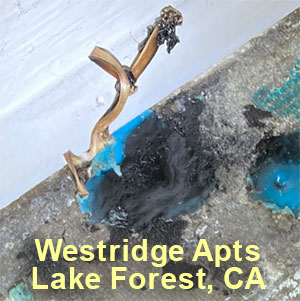
This mold can be deadly!
The photo shown left is why experts warn that mold is not something to mess with because of what it can do to your brain, your respiratory system, your skin, and so on. Just look at what it did to the cement foundation when it was discovered. The Westridge team tried to hide this mold with blue sealant, but the mold ate right through it. Scroll down to see what this mold did to a tenant's leg. This is the danger which many renters are living in right now but don't know it because the mold in their apartments has been kept hidden from them by the companies they are leasing from now.

Where mold was found
Numerous units at Westridge were tested and found to have extensive levels of moisture (mold) tied to their foundation damage, which resulted in the explosion of mold at the complex--even in the leasing office! Because of the scope of the problem, the complex should be condemned and demolished. The owners should then be held accountable for the damages to their tenants including punitive damages, damages for emotional distress, and other damages.
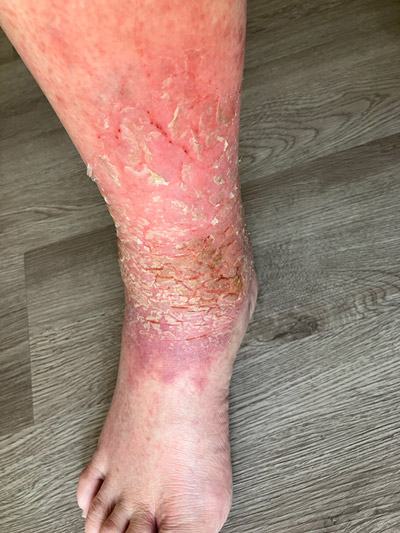
Tenant damage
This is what happened when mold spores attached themselves to a tenant's leg from the vinyl floor this tenant is standing on. The result: The formation of a skin condition called 'eczema' for which there is no cure. When this happens, the body's immune system floods the area with histamines which cause extreme itching that is often uncontrollable. The intense scratching then leads to skin damage which can make it difficult to work, sleep, put on shoes, drive, and so on. Moisture under the flooring created the growth of mold on this tenant's socks below as well. Instead of installing a vapor barrier between the flooring and the foundation, Westridge skipped this step to save costs resulting in an explosion of mold on the flooring which can be seen on a cotton ball below. Now, this former tenant is stuck with this medical issue--and medical bills--all because of the gross negligence of the Westridge Apartment management and maintenance team (litigation is pending). Respiratory problems have also been reported on the complex and are being investigated. Mold also ruined this tenant's possessions which had to be discarded at a loss of over $20K thanks to the mold problem which the complex management tried unsuccessfully to blame on the tenant.
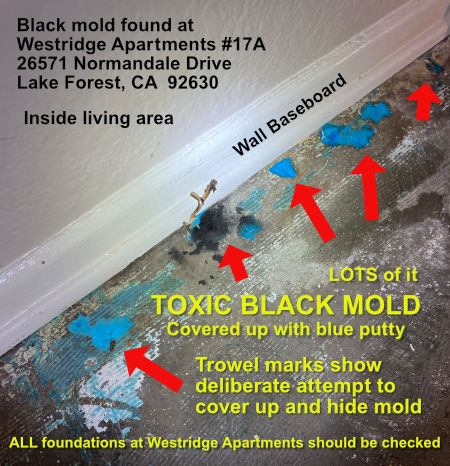
Code enforcement needed
Westridge management kept claiming that there was no visible mold in this apartment. However, when you look at the photo, you can see where they tried to cover up the black mold with blue sealant before they installed the vinyl flooring. Over time, the mold ate right through the sealant and the cement foundation itself. Contractors who have seen this photo say it provides proof that the mold was intentionally covered up by Westridge management to keep residents in the dark. As the result of this photo, contractors have said that ALL foundations at the Westridge Apartment complex should be immediately inspected because of how this same mold problem may exist in other apartments as well. Even though Westridge has a legal obligation to provide and maintain habitable units for tenants to rent, they have been thumbing their nose at this and other legal/code requirements to avoid remediation costs.
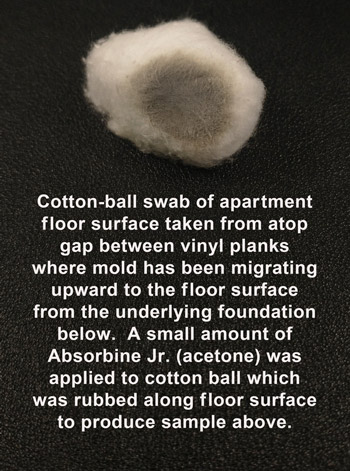
Mold swab sample
This is the result of an instant mold test taken from Apartment 17A--testing which was done live in front of the Westridge Community Manager with the same positive results as Westridge continued to deny the mold's presence. By clicking on the PDF icon above, you can see how easy it is to do this test as you are looking for a new apartment. Absorbine-Plus/Jr is best to use because Absorbine (available at Walmart and other drug stores) contains acetone (mold solvent) which picks up mold on a cotton ball relatively easily. The moisture meter in the PDF document is also a great tool to carry when looking for an apartment because it enables you to do moisture tests as you are standing inside of the unit you are considering leasing. REMEMBER THAT IF YOU DETECT ANY MOISTURE DURING YOUR MOISTURE-METER TEST, THERE IS LIKELY HIDDEN MOLD IN THE APARTMENT YOU ARE STANDING IN.

Moldy socks
In this case, a Westridge tenant reported getting black feet from walking around the inside of the apartment, mold which was very difficult to remove, even after scrubbing. The photo shown left shows what happened when the tenant then put on a brand new pair of white socks and wore them around the apartment for just a few hours. Even after these socks were washed several times, the mold stains remained. Mold also ruined this tenant's bed comforter and other possessions because of how mold attaches itself onto bedding, clothing, towels, furniture, personal possessions, and so on (more about this below). The maintenance staff tried to claim the mold was "dirt" to keep tenants from complaining.
FAKE TESTING BY CONTRACTOR "ACTORS":
Despite the effort to report the mold over and over again, the leasing office sent in contractor "actors" who faked their investigation TWICE to ensure a 'no mold' outcome after being told what to do by Westridge "handlers". Then, just days later, the tenant hired an independent contractor who discovered mold throughout this tenant's apartment.

DAMAGE KEPT HIDDEN
This is what many foundations at Westridge look like (cracks and bubbling from moisture in the foundations). In this case, paint and putty was used by Westridge to hide the foundation damage from tenants. This type of foundation damage allows moisture (and mold) to migrate up through these cracks where it makes its way inside living areas under flooring, inside walls, and so on. Leaks have also occurred because of foundation damage to in-slab plumbing.
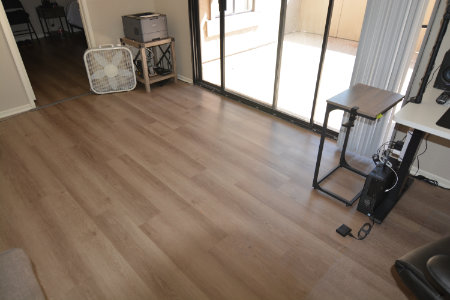
OTHER PROBLEMS
In this case, the tenant reported uneven flooring and structural issues, which is the result of underlying foundation damage. The tenant also reported issues with low water pressure and problems getting the toilet to flush. According to local plumbers, this is a common problem when in-slab pipes are crushed by the pressure being applied to foundations from the surrounding expansive soil (neighbor's entire foundation slab required replacement).
